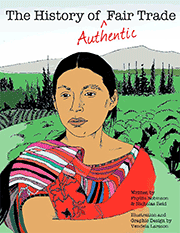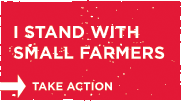
Njari, Tanzania, 2006. A meeting held by the Kilimanjaro Native Cooperative Union
As the year 2008 comes to a close, the world must cope with a recent assertion made by the Food and Agriculture Organization that “one billion people will go hungry around the globe next year for the first time in human history…”
This shameful scenario was presented in the December 28th issue of The Independent: “The shocking landmark will be passed – despite a second record worldwide harvest in a row – because people are becoming too destitute to buy the food that is produced….the growth in hunger is not occurring, as in the past, because of shortage of food – but because people cannot afford to buy it even when it is plentiful.”
Theories abound as to why the world is in this predicament and what should be done to regain control of the global food economy. Meantime, consumers in developed countries are learning more about the sometimes vast and unsustainable supply chains that bring them their food, and are questioning the enormous resources consumed to maintain this system. One movement, which gained national attention in the US with the publication of Michael Pollan’s bestseller, The Omnivore’s Dilemma, focuses on changing our eating patterns to be less global. “Locavores” recommend turning to urban gardens, supporting farmers’ markets, and even keeping a few chickens in the back yard. In short: Buy Local.
But growing one’s own food, buying local and adhering to 100-mile food diets only offer partial solutions to the growing food crisis. As valid and important as these strategies are, we must also pursue other paths if we are going to restore balance to the food system and exonerate ourselves from such an unforgiveable crime as having allowed one billion people to go hungry.
If the primary problem is not a food shortage, but rather the gap between what food costs and what hungry people can afford to pay, then we must analyze the economic and political institutional failures which have created this situation. We need to redraft our trade agreements to keep workers in sustainable jobs in the U.S. and farmers productive on their fields in the Global South. For small farmers in this country, as well as consumers, one way forward is to organize now to radically change the next Farm Bill. It’s great to see these movements gathering momentum to make dramatic changes in our agriculture and trade policies.
Where does Fair Trade Fit In?
But through all the news and the commentary about the food crisis, the problems and solutions, where is the mention of Fair Trade? Why is the voice of Fair Trade so absent within the food sovereignty movement?
It’s as if Fair Trade has fallen off the social justice map. Is Fair Trade just a fad – a naive notion that “all a consumer has to do” is “look for the seal” and the world will be a better place? Can it really be that the achievements gained and lessons learned through Fair Trade have nothing to offer the current discourse about local farmers, sustainable agriculture, and the food crisis?
The Fair Trade movement has helped millions of farmers worldwide, assisted farmer organizations, and educated consumers in the North about the injustices of our trade system. After all, it was developed in response to the huge systemic injustices facing producers in the Global South. Small farmers simply can’t compete with large landowners, plantations, and family estates. The landowners have all the connections to the same oligarchies that acquired wealth and power by enslaving generations of farmers after appropriating their land. Many of these same landowners now run the countries, make the laws, own the banks, run the exporting companies, and pocket the profits.
Fair Trade was very successful in raising awareness of this situation. Alternative traders and other activists found innovative and creative ways to “introduce” producers and consumers to each other, to build bridges between cultures. The movement educated consumers, inspired many to learn, engage and take action. Fair Trade offers market access, credit and fairer prices to millions of farmers, enabling peasant farmers to become co-operative business owners with increasing political and economic power.
Of course, if Fair Trade is barely mentioned amongst those concerned with food security and food sovereignty, try searching through the conversations about Fair Trade within the movement itself. Inspired? I don’t mean to offend, but the dialogue can get tiring. “Fair Trade,” “Whole Trade,” “Direct Trade”, “Beyond Fair Trade” — does the Fair Trade movement have nothing more to offer consumers and activists than rivalries between roasters; who makes more trips to source; who knows their farmer partners better?
Fair Trade must join in discussions about our industrial food system, the plight facing small farmers in the US, and the governmental policies that created the industrialized food economy in which we all are forced to participate. We need a rich debate within the movement about these larger issues that affect small farmers and consumers.
Bringing it All Together
Some of us are thirsting for a deeper level of conversation. Personally, I want to see Fair Trade raised alongside the “buy local” and agriculture and trade policy reform strategies. Gains have been achieved and lessons learned. Why isn’t the Fair Trade movement influencing – and being influenced by – the food sovereignty movement?
Fair Traders need to get back into the ring or we will lose the advances the movement has made. It’s time to tone down the marketing rhetoric and return to the educational goals of our mission; find new ways to talk with consumers – and each other – about our work and why we’re doing it. Most importantly, we need to continue creating innovative new strategies, and joining others, to fix the huge injustices in our food system and large scale destruction of the planet.
I also think that “locavores”, who talk about the need to support small farmers, community development and sustainable agriculture, should consider expanding their lens to include mention of small farmers in the Global South. As long as consumers continue to drink coffee and tea, and eat chocolate and other foods not grown in our country, let’s remember that the struggles of these small farmers are as challenging and as critical as those in the U.S. And while small farmers participating in Fair Trade are not in our own backyards, they are trying to maintain, and strengthen their own local communities. Their food security depends on their ability to remain organized in co-operatives; to receive the higher, “fairer” prices they deserve; and ultimately, on the agriculture and trade policies we enact here in Washington.
By the same token, when we talk about the role agri-business has played in dictating agriculture, economic, and trade policies, it would be powerful to highlight alternatives. If the large-scale mechanized farming favored by agribusiness – with its reliance on fossil fuel, pesticides, genetically modified organisms, government subsidies, and factory farms – is the problem, which businesses within the food system are offering solutions?
Certainly small farmers are central to our vision of a greener and more just food system. But it is important also to recognize the significance of the food co-operatives, locally-owned natural food markets, independent restaurants and cafes, which shine as visible examples of those who are building an alternative day after day.
Why is there so little mention of these independent and co-operative businesses in food security circles? Many alternative trade organizations, and worker-owned co-operatives are demonstrating that businesses can have a social mission; reasonable profits can be made and shared more equitably amongst workers and farmers; business can be conducted through strong relationships based on mutuality, transparency and integrity; and of course that healthy food can be produced sustainably.
These organizations – producing, manufacturing, distributing and selling us our food – are walking the walk. They are demonstrating through action that alternatives do exist. Positive models are out there. And the more we can highlight, replicate and create additional independent, local and co-operative businesses, the more success we will have building the type of food system that the food sovereignty movement and all the locavores, fair trade and agriculture policy activists are promoting: a food system based on the principles of solidarity, sustainability and co-operation.
Our movements for a greener and more just food system could benefit by engaging more with each other. Ultimately, the more we challenge, learn from, influence and highlight the contributions each movement is making, the stronger and more successful we will be in our ultimate goal of fixing a broken food system. Let’s unite, deepen and strengthen our movements. With the threat of one billion people facing hunger and food security in 2009, it’s a change we can’t afford not to make.
Read Full Post »





